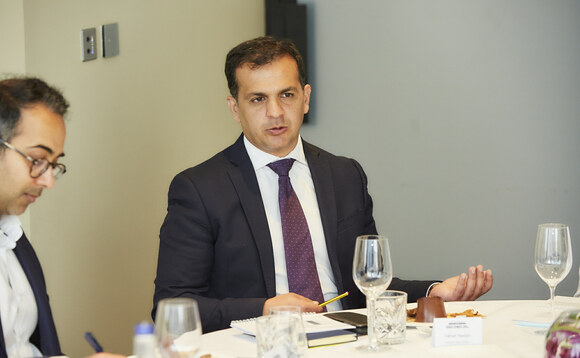Multi-asset managers have been sharing their strategies for navigating turbulent market conditions, including taking advantage of decade-high sector dispersions, while they also discussed possible re-entry points for the hard-hit technology sector.
Taking part in an Investment Week roundtable in association with State Street Global Advisors on 16 June, Vipul Faujdar, SPDR's ETF UK sales specialist and SPDR head of smart beta sales EMEA, began the discussion by sharing the group's insights on ETF flows in the first half of the year.
"Last year was a record year for factor ETF inflows at £9bn, but we have already seen £10bn flowing into factor ETFs in Europe this year already," he said.
"On the sector side, the top-to-bottom dispersion is pretty much at a decade-long high, with energy at the top obviously. The width of that sector dispersion as well has meant that a lot of players who were not using sectors in the past have come back in."
"The year started with financials taking the majority of inflows in sector ETFs, but that quickly dissipated as the curve flattened. After February, we have seen consistent outflows, and I think Russia and Ukraine just sped that up. Energy has continued to see inflows, mainly in Q1, but even throughout Q2 investors are still allocated to energy. That is a hedge trade that we think investors are still underweight. In May, consumer staples were the big trade and utilities, so all the defensives were dominating sector inflows."
Tim Edwards, managing director and global head of index investment strategy at S&P Dow Jones Indices, also highlighted the "astonishing spread" in sector performance this year. According to S&P Dow Jones Indices performance data for S&P 500 sectors for the year-to-date to 31 May, the top-performing Energy sector soared 58.5% compared to a drop of 24.7% for the worst hit Consumer Discretionary sector.
"That 80% or so spread between energy and consumer discretionary is off the scale, in terms of the first five months of the year. This is an overused word, but appropriate: it is absolutely unprecedented," Edwards said.
"Throughout 2020, the primary driver was growth versus value, and everything could be best understood through a factor perspective. That really drove the risk perspective throughout the market, but over the past year that has collapsed almost down to nothing. The risk expression is all through sector perspectives, and just knowing that helps you navigate the current markets."
Sector flows
SPDR's Faujdar noted the group has seen wealth managers who have traditionally used geographically-focused products move to sector ETFs, because they can predict the economic cycle even more and use them more strategically.
Sekar Indran, senior portfolio manager at Titan Asset Management, said the team was using sectors for tactical positioning in the current market climate.
"We are overweight US healthcare which is geared to the quality factor given the balance sheet strength of the companies within the sector. The inelastic demand for healthcare services and products combined with the sector's relatively strong pricing power provides some insulation from rising input costs and slowing growth, suiting the sector to the current macroeconomic environment."
Speaking as part of the discussion, a London-based multi asset portfolio & risk manager of an investment management firm, commented: "We are underweight US tech stocks, and we are also looking at some of the electric car companies, graphite companies, and precious metals such as gold and silver because of the Ukrainian war which we think will end around September. We continue to observe market conditions from the sideline in a mainly cash position at this time. We saw a lot of geopolitical events occur in February and March and before the end of the tax year, so that is why we continue to exercise caution during this turbulent period of uncertainty which has seen heightened market volatility occur in recent months as a result."
Technology sector
The panel were also keen to discuss the right time to return to the battered technology sector and whether it may provide defensive qualities for portfolios in the face of recessionary fears, as seen at the height of the Covid-19 pandemic.
S&P Dow Jones Indices' Edwards commented: "Technology was defensive in 2020, but I think for some unique and almost impossible to replicate conditions. Generally speaking, tech is not defensive. In a rising rate environment, it is really hard for it to be defensive, just by the nature of it being a growth sector and the natural duration comes in.
"But are there parts of the technology sector which, 22 years after the tech bubble, have become more defensive names themselves? I think you could look at certain names, and I think a factor perspective is helpful in identifying them, so you are looking for quality and dividend income."
Weixu Yan, investment director at Close Brothers Asset Management, agreed there is a high level of dispersion within the broader technology sector and this merits a closer look.
"You have super high, crazy growth tech, like your Zooms and various little niche providers, and then your established tech like Microsoft, which is doing okay, and then you have older tech. Do not consider them as one.
"Given a recessionary environment, we would not stop using this space. With Microsoft, you will still pay for your Windows licences but obviously if you buy into something like a gaming accessory maker, for example, they might suffer because you are cutting off your spending on that side."
Momentum indicators
Fahad Hassan, CIO at Albemarle Street Partners, was also keen to discuss how investors could use momentum indicators to help time these kinds of decisions.
"In terms of timing, obviously the Fed and inflation data are going to have a large part to play but it is difficult to disaggregate the profitless, pie-in-the-sky type stories from the more defensive names. You can start buying the defensive names when you are comfortable the Fed has done enough because Microsoft is going to be profitable regardless, and you are willing to take the valuation pain because you will get paid a dividend, and you will see the other side of the earnings recovery as and when it happens. There is a difference there, and I think the overlap with quality is quite high. Microsoft therefore is more quality than growth. The way you would do it is you would use momentum indicators.
"One of the things that is sometimes lost in factor investing is how a little bit of momentum goes a long way. Mixing a bit of momentum with value or growth, or anything else, is going to keep you out of trouble buying those falling knives.
"For people saying value is having a great time, it depends on what part of value you are in. Having some level of momentum built into some of these more traditional factors deals with some of those issues. I think momentum is the factor that keeps you out of trouble in these more troubled times."
This post was funded by State Street Global Advisors




























